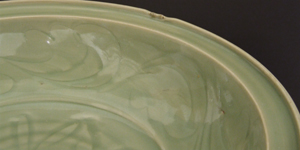
YUAN DYNASTY 1279 – 1368 Longquan Celadon Ware
A Fine Yuan Longquan Celadon Ware Dish, Late 13th to Early 14th Century, Longquan Kilns, Zhejiang Province. The Shallow Sides Support a Flat Everted Rim that has a Ridge, Covered in a Rich Clear Celadon Green Glaze. The Center of the Dish is Freely Carved in Long Flowing Lines with a Flowing Lotus. The Cavetto is Similarly Decorated. The Foot is Recessed with an Unglazed Ring Burnt Orange in the Firing.
SOLD
- Condition
- No damage but a firing fault to the rim, see photographs.
- Size
- Diameter : 35.3 cm (13 3/4 inches).
- Provenance
- N/A
- Stock number
- 22907
- References
- For a very similar Yuan Longquan celadon dish see : Chinese Ceramics from the Meiyintang Collection Volume 1 (Regina Krahl, Azimuth Editions, 1994) page 300 plate 561. For similar Yuan Celadon Dish dishes of this design, where the author mentions that a fragment of a similar dishes were found on the Xisha islands in the South China Sea, see : Chinese Ceramics in the Topkapi Saray Museum Istanbul, A Complete Catalogue, Volume 1, Yuan and Ming Dynasty Celadon Wares (Regina Krahl, Published in association with the Directorate of the Topkapi Saray Museum by Sotheby`s Publications 1986) page 259, plate 72.
Information
Celadon Ware :
Celadon is a term used to describe several types of Chinese stoneware and porcelain, as well a ceramics from other countries, notably from Korea and Japan. The term is a imprecise one, applying to various types of green glazed ceramics, but not all ceramics with green glazes, there are several wares that have a green glaze that are not refereed to as celadon. For example Green Jun and Ge Ware. For this reason there has been a move to try to clarify the situation by using the term `Green Ware`. But for now Celadon is a more familiar and therefore useful term. The origins of the term Celadon are not clear, one theory is that the term first appeared in France in the 17th century and that it is named after the shepherd Celadon in Honoré d`Urfé`s French pastoral romance, L`Astrée (1627), who wore pale green ribbons. (D`Urfe, in turn, borrowed his character from Ovid`s Metamorphoses.) Another theory is that the term is a corruption of the name of Saladin, the Ayyubid Sultan, who in 1171 sent forty pieces of the ceramic to Nur ad-Din, Sultan of Syria. Yet a third theory is that the word derives from the Sanskrit sila and dhara, which mean "stone" and "green" respectively. Celadon ware originated in Zhejiang Province in the Eastern Han Dynasty, however green monochrome glazes can be found on stoneware much before that date. Zhejiang is were the famous Longquan Celadons were made but Celadon wares were also produced at Jiangsu, Hubei, Hunan and Jiangxi. The production of Celadon Ware required a reducing atmosphere of around 1300 degrees C., the colouring agent was a mixture of iron oxide and titanium. The glaze was applied very thickly, and was full of tiny bubbles which defuse the light giving the appearance of richness and softness. Celadon ware originated in Zhejiang Province in the Eastern Han Dynasty, however green monochrome glazes can be found on stoneware much before that date. Zhejiang is were the famous Longquan Celadons were made but Celadon wares were also produced at Jiangsu, Hubei, Hunan and Jiangxi. The production of Celadon Ware required a reducing atmosphere of around 1300 degrees C., the colouring agent was a mixture of iron oxide and titanium. The glaze was applied very thickly, and was full of tiny bubbles which defuse the light giving the appearance of richness and softness.
Lotus :
The lotus is one of the most important symbols in the Chinese art. This Buddhist emblem is a symbol of purity, as the perfect flower grows out of muddy ponds without a stain. The words for lotus in Chinese has the same meaning as to bind, connect (in marriage). It is one of the Eight Auspicious Symbols of Buddhism. It is the flower used to represent summer.


